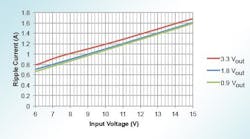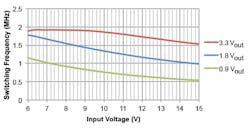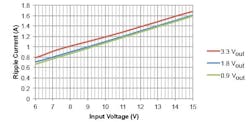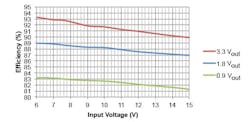This file type includes high resolution graphics and schematics when applicable.
A common challenge faced by every power-supply designer is the ability to achieve high-efficiency targets with lower-output-voltage step-down converters. For example, a 3.3-V output-voltage power supply may provide 91% efficiency at its full load, whereas a 1.8-V version may provide only 84% at full load. This decrease in efficiency produces higher operating temperatures than otherwise would be possible. And for portable systems, it wastes too much battery power. The hotter operating temperatures or shorter battery run times are clearly not desired by those using tablets, servers, or solid-state drives (SSDs) that contain these power supplies.
A new power-conversion approach is needed to keep efficiency high, regardless of the output voltage. One such method, automatic efficiency enhancement (AEE), provides higher efficiency with lower output voltages in these types of systems.
Why Does Efficiency Drop?
The efficiency drop for lower output voltages relates directly to the decreased amount of output power without a corresponding decrease in power loss. In a step-down converter, the losses are grouped into switching losses and conduction losses. Switching losses mostly depend on the input voltage, output current, and switching frequency. Conduction losses mostly depend on the output current and MOSFET resistances. Since the output voltage isn’t a strong contributor to the amount of loss, the losses don’t decrease as much as the output power.
Lower output voltages mean less output power, which is output current multiplied by the output voltage. Since efficiency is defined as output power divided by the output power plus the losses, lower efficiency results from the lower output power—but with the same losses.
As an example, a 3.3-V output-voltage power supply delivering 6 A of output current with 2 W of loss produces 91% efficiency. The same power supply configured for a 1.8-V output voltage generates about the same 2 W of loss. This results in 84% efficiency due to the reduced output power. When configured for a 0.9-V output voltage, this 2 W of loss yields just 73% efficiency. Because the switching frequency, MOSFET resistances, output current, and input voltage are held constant in this comparison, losses are roughly the same, with 7% and 18% lower-efficiency results, respectively.
Two Higher-Efficiency Solutions
Input voltage and output current are defined by the system and load; thus, they’re not easily changeable. Power-supply designers need to either lower the switching frequency or adjust the MOSFET resistances to obtain higher efficiency for lower output voltages.
Usually, it’s impossible for power-supply designers to adjust the resistance values, because both high- and low-side MOSFETs are integrated inside most modern step-down converters. While it may be possible to have multiple step-down converter integrated circuits (ICs) available for use—each optimized for a specific output voltage—this isn’t generally practical from an IC design perspective. As a result, it’s typically not present in the market. It also creates more ICs in the bill of materials (BOM), which complicates the system design.
Lowering the switching frequency reduces the switching losses and increases efficiency. In many integrated step-down converters, it’s possible to adjust the frequency. However, adjusting the switching frequency usually necessitates a recalculation of the output filter and loop-compensation circuitry. This requires more design effort and time, and probably different components for different output-voltage circuits in the system. And that, once again, increases BOM count.
Intelligently Adjust Switching Frequency with AEE
Without any designer intervention, AEE adjusts the switching frequency to increase efficiency while using the same output filter and loop compensation. The switching frequency is automatically adjusted, based on the input voltage and output voltage, to maximize efficiency while maintaining control-loop stability and output-filter effectiveness. The frequency needn’t be set at a specific operating point optimized only for certain operating conditions; it dynamically adjusts itself during operation. Figure 1 shows the switching frequency for 3.3-, 1.8-, and 0.9-V output-voltage circuits running at 6 A of load current across a 6- to 15-V input-voltage range.
For lower output voltages, the switching frequency is reduced to maintain an appropriate amount of ripple current in the inductor. In the more common peak-current-limit type of step-down converter IC, the peak inductor current defines the IC’s available output current.
With the fixed level of the current limit set inside the IC, the peak inductor current must remain below the current-limit level at the full output current. Since the peak inductor current is the output current plus half of the inductor ripple current, the ripple current must be maintained at a low enough level. Otherwise, current limit is reached too soon and the IC is unable to provide the necessary output current.
With lower output voltages, the inductor ripple current is already reduced through Equation 1:
ΔIL = VOUT × (1 – VOUT/VIN)/(L × FSW) (1)
Because of this reduction, the switching frequency is also reduced with lower output voltages, increasing the ripple current back toward its allowed level. Figure 2 depicts the inductor ripple current calculated from the frequency data in Figure 1 and Equation 1.
At a given operating point, the ripple current is essentially the same, regardless of the output voltage. AEE achieves this by reducing the switching frequency at the lower output voltages. Such a reduction narrows the gap in efficiency that occurs with decreasing output voltage. Figure 3 shows the efficiency when implementing AEE.
Because the lower frequency at lower output voltages reduces switching losses, it also reduces total loss. This increases efficiency as opposed to most power-conversion topologies, which maintain a constant frequency for all output voltages.
This file type includes high resolution graphics and schematics when applicable.
Conclusion
In step-down converters such as the TPS62180, AEE provides higher efficiency than fixed-frequency, step-down converter topologies for lower output voltages. With AEE, 91% efficiency for a 3.3-V output voltage is maintained at a high level for lower output voltages: 87.5% for a 1.8-V output voltage and 82% for a 0.9-V output voltage. Such efficiencies represent a 3.5% and 9% increase, respectively, compared to fixed-frequency topologies. These efficiency increases are greatly valued in portable devices such as tablets, as well as thermally sensitive devices like SSDs and servers.





